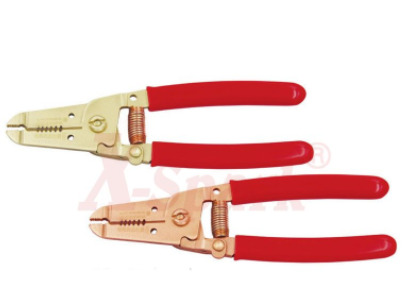Every professional electrician makes daily use of a common tool known as a wire stripper and most own several different forms of this tool. Every DIYer who does any kind of electrical repair should also own some version of a wire stripper. Especially useful is a version commonly known as a combination tool, which not only has a wire stripping function, but also pliers jaws, cable-cutting blades, and a couple of threaded holes for cutting bolts commonly used with electrical boxes.
What Is a Wire Stripper?
A wire stripper is a hand tool designed to remove the protective covering, or jacket, from electrical wires. By removing the jacket, the wire stripper helps the electrician expose the wire for new uses or repairs.
Wire Stripper vs. Self-Stripping Tool
Another type of wire stripper is a self-stripping tool, or self-adjusting wire strippers, that removes wire insulation with a compound action. This means that three actions take place when you squeeze the handle: grip, strip, and remove. After you precisely place the wire in the head and squeeze the handle, the stripper grabs onto the wire, cuts the insulation, and completely removes it from the wire, all in one motion. Self-stripping wire strippers are more expensive than normal strippers. They serve one function only and are normally owned by professional electricians who prefer specialty tools for each function.
Wire Stripper
More affordable
Requires careful placement
Self-Stripping Tool
Three times more expensive
Cuts and removes in one motion
Wire Stripper vs. Combination Wire Stripper
Combination wire tools, or combination wire strippers, are multi-function tools that have sharp cutting jaws to cut non-metallic (NM) cables or to trim individual wires down to size. They may also have pliers jaws that can be used to bend wires. The same jaws may also be used to ream the inside of the metal conduit after it is cut, using the outsides of the jaws when they are in the closed position.
Most combination strippers also have two different holes for cutting machine bolts, usually 6-32 and 8-32 sizes. You thread a bolt into the hole to the desired depth, then squeeze the tool's handles to cut off the end of the bolt. When you twist the bolt out of the hole, the threads in the hole realign the threads on the cut end of the bolt.
Wire Stripper
Designed only for wires
Offers guides for proper cutting length
Combination Wire Stripper
Can cut wires and bolts
Can be used to bend wires
>> Shop for our wire stripper here
Parts of a Wire Stripper
In whatever form the tool takes, a wire stripper has a series of labeled holes that match the common wire gauges, typically 10-gauge to 20-gauge. When you insert the wire into the proper hole and squeeze the tool's handles, it precisely severs through the plastic insulation layer without damaging the copper wire. The tool then removes the wire insulation, using one of two methods.
It's important to note that copper wire commonly comes in either solid or stranded forms. Stranded wire is slightly larger in diameter than solid wire of the same gauge. For this reason, wire strippers often have two sets of numbers indicating the stripper hole sizes. For example, the hole that is marked for 10-gauge solid wire is the same hole you use for 12-gauge stranded wire. Always make sure you're using the correct set of markings for the wire type you are cutting.
How to Use a Wire Stripper
Although different manufacturers offer different versions of the tool, the process for stripping wires is largely the same with each tool. This is the process for the standard or combination-style tool:
1. Determine the Wire Gauge and Type
Identify the gauge of the copper wire to be stripped. You can find this on the outermost sheathing that binds multiple wires together inside an NM cable (nonmetallic sheathed cable). With a number such as 12/2, for example, the first number is the wire gauge (in this case, 12). Also, note whether the wire is solid or stranded copper.
2. Determine the Wire Gauge and Type
Identify the gauge of the copper wire to be stripped. You can find this on the outermost sheathing that binds multiple wires together inside an NM cable (nonmetallic sheathed cable). With a number such as 12/2, for example, the first number is the wire gauge (in this case, 12). Also, note whether the wire is solid or stranded copper.
3. Open the Wire Stripper and Seat the Wire
Open the wire stripper handles. "Seat" the wire into one side of the proper hole. Slowly press the handles together until they can go no farther. This action will cut through the insulation on the wire.
4. Twist the Tool (if Needed)
If the wire insulation does not fully cut, you may have to gently rotate the wire within the hole (or the wire stripper around the wire, whichever is easier). You do not have to rotate far: just a quarter turn in one direction and back.
5. Strip the Insulation
Pull the wire stripper towards the cut end of the wire to remove the insulation. The action is like pulling a sock off a foot. Some users find it easiest to push against the tool using the thumb on the hand that is gripping the wire, while the other hand holds the handles of the tool firmly shut.
We are a wire stripper supplier. Please feel free to contact us if you need them!

评论
发表评论